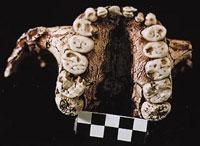New branch of the human family tree discovered in Ethiopia
It has had only a few teeth and pieces of bone, but they have been enough to get some clues about the first human ancestors and create many doubts.

The newly discovered fossil is from the time when the lines of monkeys and human ancestors were distributed, or something later. The fossils of that time are scarce and the information derived from them is confusing and controversial. Therefore, based on genetic and biomolecular analysis, it has been estimated that the oldest common ancestor of monkeys and humans lived about 6 million years ago.
Until last February, the 4.4 million year-old Ardipitecus ramidus was the oldest known hominid. It stood on the human line after the divergence of lines. But in February researchers working in Kenya unveiled an older hominid called Orrorin tungenensis. The fossil Orrorin tungenensis, 6 million years old, suggested that it was the oldest ancestor of man, while considering that Ardipitecus ramidus was not part of the human line. According to them, A. ramidus looked more like monkeys than humans. However, the fossil presented today has put Ardipitecus ramidus back on the hominid line and has doubted that Orrorin is hominid tungenensis.

The debate is on the table and, if clarified, can yield very substantial results. In fact, one of these old beings can be the ancestor of monkeys, and so far such fossils have never been found. On the other hand, it can be a being prior to the division of the two lines, that is, of a common ancestor or just after the division of them. In any case, it will be a very valuable tool to know a key era in human evolution.
So far it is only clear that that being lived in the woods and is not little. It has traditionally been considered that human ancestors lived in regions such as savannah, that is, after leaving the forest hominids began to evolve. But recent studies show that the first hominids have been able to live in forests. What was published today has followed the same line.
Complementary articles:
And to eat, mammoth or paleosoarra?
More information in Nature
Buletina
Bidali zure helbide elektronikoa eta jaso asteroko buletina zure sarrera-ontzian











